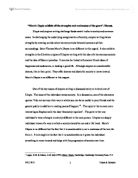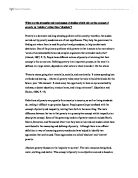Starr’s measure of risk was the “statistical expectation of fatalities per hour of exposure to the activity in question”. In the case of voluntary activities, the benefit to the individual was given the same value as the amount of money it cost the person to take part in that activity. In the case of involuntary activities, the amount of money that was added to the person’s income by taking part in that activity was taken as the value of the benefit. Starr actually stated himself that this was an “overly simplistic” way to calculate the benefit.
Starr’s ideas have several advantages; it was the first article to suggest a model that could be used to analyse societal risk and an excellent starting point for further research. It explained a clear, simple and workable method and took into consideration societal attitudes towards risk.
There were, however, several weaknesses in Starr’s model. The fact that the model relied on the past behaviour of the public towards new technology to predict the future behaviour is one such weakness. The model also assumes that previous accident records are reliable and does not take into account that accident records for old technologies may not be a suitable predictor for assessing the risks of new technology an example of this would be basing assessments of the safety of nuclear power plants on the accident history of coal burning plants. The model fails to distinguish what is best for society from what is traditionally acceptable. The values on benefits are calculated in an overly simple way and the risk only includes fatalities and does no take into account disease and injury. He also completely fails to take into account emotional responses to risk and expects individuals within society to view risk in the same way.
After Starr’s first piece on the assessment of societal risk, many other writers followed suit. Some agreed with Starr’s approach, either using it for their own agenda or trying to expand on his work while others criticised this technocratic approach.
One writer who tried to expand on Starr’s approach was David Okrent, who wrote the article “Comment on Societal Risk” which appeared in the journal; Science, volume 208, issue 4442, page 372-375, in 1980. Okrent believed that a more accurate method for measuring societal risk was required. Okrent believed that cost benefit analysis is an important part of societal risk assessment and should be “judiciously employed”. Okrent believed that the strategy for calculating risk contained too many flaws. He wanted to set standards for the way in which calculations were carried out including the disclosure of assumptions on which the calculations were based and to set a standard value on life. His article includes many examples of risk assessments carried out that he feels are in need of a better approach. His belief is that risk is not being managed in a cost effective manner and as a result unnecessary lives are being lost. This is due to discrepancies within various industries on the value of life and other flaws in the calculations which is not allowing for a true picture to be seen of the risk involved in each industry. Although his idea and intentions are good, his method contains flaws. His aim to fix a value to life is morally wrong and he does not acknowledge the rights of the public or the importance of public perception of risk.
A good example of a writer who took Starr’s model of cost benefit analysis and used it to justify an untrue argument for his own agenda is L.A. Sagan, who wrote the 1972 article “Human Costs of Nuclear Power” taken from the journal; Science, volume 177, issue 4048, pages 487-493. Sagan used cost benefit analysis to prove not only that Nuclear power was safe, but insinuated that not using nuclear power was morally wrong and argued that the Nuclear Energy industry was over regulated compared to other ‘similar’ industries such as coal burning. This was wrong as the comparisons are unfair taking onto account the length of time for which coal burning has been used to produce electricity compared to the length of time nuclear energy had been used, the conditions of the premises which these activities were carried out, and also the unknown long term affects of using nuclear power. This article was a classic example of how cost benefit analysis was an unreliable method for calculating risk due to the fact that figures could be easily manipulated to produce whatever result was desired.
Joel Yellin criticised the technocratic approach to the analysis of societal risk in his 1976 article “The Nuclear Regulatory Safety Commissions Reactor Safety Study” taken from “The Bell Journal of Economics”, volume 7, issue 1, page 718-723. Yellin says that the calculations of cost benefit should not be trusted and those which have been done in the nuclear industry are wrong as there is no suitable information to base them on.
R.A. Brown and C.H. Green also heavily criticised cost benefit analysis as a method of assessing societal risk in their 1980 article taken from “the Journal of the Operational Research Society”, volume 21, issue 7, pages 563-571, titled “ Precepts of Safety Assessment”. They believed that the quantitative method of assessing risks is unacceptable and criticised scientists’ assumption that the public were ignorant. They also studied public perceptions of risk and found that the public feared more risks that would affect a large number of people at once and that the public did not trust scientists. They also said that safety measures that bring benefit to a lot of people should be supported and deterioration of safety levels that could be damaging to a large number of people should be prevented.
In 1980 Chauncey Starr wrote another article with Chris Whipple titled “Risks of Risk Decisions”. This was published in Science, volume 208, issue 4448, pages 1114-1119. In this article, Starr makes a u-turn on the direction of his earlier work, focussing on public perceptions and acceptance of risk. In this article, Starr and Whipple address the problem of predicting the level of risk which the public will find acceptable. Starr and Whipple reinforce the point made in Starr’s earlier piece of work that voluntary risks are more acceptable to the public than risks that are imposed on them and goes on to say that decisions are made all the time that impose risks on the public and that these can cause conflict and this conflict must be appropriately managed in order to prevent escalation. Starr and Whipple recognise that individual perceptions of a risk may vary and might be very different from the actual probability and severity of the risk. This makes it impossible to please everyone in attempts to control a risk as some could see the risk as minimal, some could see it as manageable, while some could see the same risk as intolerable. They also make the statement that the higher the social benefits of a risk, more likely the risk would be accepted by the public,
They also examine the risk decision making process which, they say aims to minimise social costs while maximising social benefit. They claim that an advantage of analytical methods is that they produce data on which logical decisions can be based but that it is not always publicly acceptable to base decisions on these alone. They highlight several problems with these analytical methods. One of the problems being that factors that should be included in a cost benefit analysis may be intangible. Another problem being that a risk assessment carried out by an individual will be biased by the individual’s view of the risk. They also claim that social benefits and social costs should be looked at completely separately as one can cloud your judgement of the other. They raise the issue of measuring and making decisions on how to deal with a risk that might not arise for generations. The impossibility of eradicating risk completely is also recognised and the need to establish maximum permissible risk values. The main reason for this article being described as a u- turn for Starr is the statement that due to the complexities of evaluating risk in a purely mathematical method, it is better to involve common sense and group discussion in the decision making process.
In comparison, the article, “Risks of Risk Decisions” offers a much more credible approach to the assessment of societal risk. Starr’s first article was an excellent starting point for societal risk assessment but “Risks of Risk Decisions” offers a much more comprehensive method for the assessment of risks. The importance of the public’s opinions and feelings is too large to be ignored as it is the public who have to bear the risk of risk decisions made by controlling bodies.
BIBLIOGRAPHY







